 W
WThe aurochs, also known as urus or ure, is an extinct cattle species that was first described in 1827. It was native to Asia, Europe and North Africa and survived in Europe until 1627, when the last recorded aurochs, a female, died in Jaktorów forest in Poland. It is the ancestor of domestic cattle. During the Neolithic Revolution at least two aurochs domestication events occurred: one involving the Indian aurochs leading to the zebu cattle and the other involving the Eurasian aurochs subspecies leading to the taurine cattle. Many breeds of modern cattle share characteristics of the aurochs, such as the dark colour in the bulls with a light eel stripe along the back, the cows being of a lighter colour, or an aurochs-like horn shape.
 W
WBeatragus antiquus, the ancient hirola, is an extinct species of alcelaphine antelope that lived in Africa during the Plio-Pleistocene.
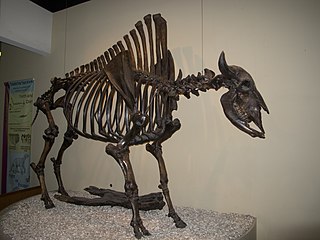 W
WBison antiquus, the antique or ancient bison, is an extinct species of bison that lived in Late Pleistocene North America until around 10,000 years ago. It was one of the most common large herbivores on the North American continent during the late Pleistocene, and is a direct ancestor of the living American bison along with Bison occidentalis.
 W
WBison latifrons is an extinct species of bison that lived in North America during the Pleistocene epoch ranging from Alaska to Mexico. It was the largest and heaviest bovid ever to live in North America. It thrived in North America for about 200,000 years, but became extinct some 20,000–30,000 years ago, at the beginning of the last glacial maximum.
 W
WBootherium is an extinct bovid genus from the middle to late Pleistocene of North America which contains a single species, Bootherium bombifrons. Vernacular names for Bootherium include Harlan's muskox, woodox, woodland muskox, helmeted muskox, or bonnet-headed muskox. Bootherium was one of the most widely distributed muskox species in North America during the Pleistocene era. It is most closely related to the modern muskox, from which it diverged around 3 million years ago, it is possibly synonymous with Euceratherium, although this is uncertain.
 W
WBos palaesondaicus occurred on Pleistocene Java (Indonesia) and belongs to the Bovinae subfamily. It has been described by the Dutch paleoanthropologist Eugène Dubois in 1908. The holotype of Bos palaesondaicus is a skull from Trinil. This species is the likely ancestor to the banteng.
 W
WBubalus mephistopheles, also known as the short-horned water buffalo, is an extinct species of bovine that lived in China during the Pleistocene and Holocene. It survived into historic times, perhaps as recently as 1200 BC.
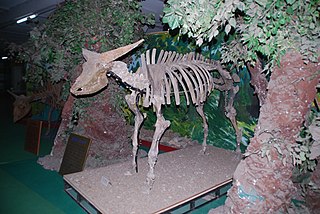 W
WBubalus wansijocki is an extinct species of water buffalo known from northern China during the Late Pleistocene.
 W
WCamelini is a tribe of terrestrial herbivores in the family Camelidae, endemic to Asia, North America, and Africa from the Late Eocene to the present. It includes the living genus Camelus as the type genus. At least one genus, Eulamaops, reached South America.
 W
WCamelops is an extinct genus of camels that lived in North and Central America, ranging from Alaska to Honduras, from the middle Pliocene to the end of the Pleistocene. It is more closely related to the Old World dromedary and bactrian and wild bactrian camels than the New World guanaco and vicuña, and alpaca and llama, making it a true camel of the Camelini tribe. Its name is derived from the Ancient Greek κάμηλος and ὄψ, i.e. "camel-face".
 W
WCandiacervus is an extinct genus of deer native to Pleistocene Crete. Due to a lack of other herbivores, the genus underwent an adaptive radiation, filling niches occupied by other taxa on the mainland. Due to the small size of Crete, the genus underwent insular dwarfism, the smallest species, C. ropalophorus, stood about 40 cm at the shoulders when fully grown, as can be inferred from a mounted skeleton. Some species are noted for their peculiar, spatula-shaped antlers, though other species have normal albeit miniaturized antlers. Other features are the relatively short limbs, the massivity of the bones and the simplified antler.
 W
WCapromeryx minor, sometimes known as the dwarf pronghorn, is a very small, extinct species of pronghorn-like antilocaprid ungulate discovered in the La Brea Tar Pits of California and elsewhere. It has been found at least as far east as the coast of Texas. It stood about 60 centimetres tall at the shoulders and weighed about 10 kilograms (22 lb). It is unclear whether females had horns as well as males. Each horn consists of a pair of short, straight points that sprout from a single base on either side of the head, with the two prongs parallel rather than diverging as in Tetrameryx and Stockoceros. A number of different species have been described which are likely all the same: Capromeryx furcifer, Capromeryx mexicana and Capromeryx minimus. Capromeryx furcifer would have priority as the proper name for the Late Irvingtonian through Rancholabrean species in which the anterior prong is less than 50% the height of the posterior prong. Its fossils have also been found at least as far east at as the Texas coast, as well as in Nebraska, Kansas, New Mexico, Sonora, Baja California, and near Mexico City. Specimens of this species date to the Late Irvingtonian and Rancholabrean periods. Two earlier species are known: Capromeryx tautonensis from Washington state and from Central Mexico in the Early Blancan, and Capromeryx arizonensis from the Late Blancan in Arizona, New Mexico and Florida. These two earlier species were larger and heavier than the Pleistocene species. It is thought by some biologists that it lived in forests and underbrush, where its small size would have helped it to hide. It is unlikely that it lived in open prairies, since it would not have been fast enough to outrun the predators of that time.
 W
WCelebochoerus is an extinct genus of giant suid artiodactyl that existed during the Pliocene and Pleistocene in Sulawesi, Indonesia, and the middle Pleistocene of Luzon, in the Philippines.
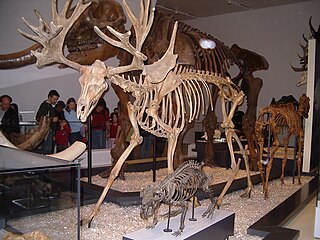 W
WCervalces is an extinct deer genus that lived during the Pliocene and Pleistocene epochs. Cervalces gallicus is either classified as a species of the related Libralces, or an ancestral species to other members of Cervalces. It lived in Europe from the Pliocene to the Pleistocene. Cervalces scotti, the stag-moose, lived in Pleistocene North America. Cervalces latifrons, the broad-fronted moose, and Cervalces carnutorum were found in Pleistocene Europe and Asia.
 W
WCervalces latifrons, the broad-fronted moose, was a giant species of deer that inhabited the holarctic regions of Europe and Asia during the Pleistocene epoch. It is believed to be the largest species of deer that ever existed, larger than its North American relative Cervalces scotti, Megaloceros, and the modern moose.
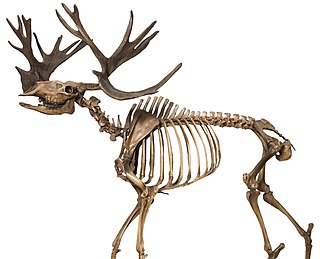 W
WCervalces scotti, the elk moose or stag-moose, is an extinct species of large deer that lived in North America during the Late Pleistocene epoch. It had palmate antlers that were less complex than those of a moose and a muzzle more closely resembling that of a typical deer. It is the only known North American member of the genus Cervalces.
 W
WCervus astylodon, the Ryukyu dwarf deer, is a recently extinct species of cervid that was endemic to the Ryukyu islands. It lived throughout the Pleistocene, going extinct as recently as 20,000 BP.
 W
WCroizetoceros is an extinct genus of deer which lived throughout much of Europe, first appearing during the last stages of the Miocene and living until the Early Pleistocene.
 W
WThe Cyprus dwarf hippopotamus or Cypriot pygmy hippopotamus is an extinct species of hippopotamus that inhabited the island of Cyprus until the early Holocene.
 W
WDamalops is an extinct genus of Alcelaphinae. It lived during the Pliocene and Pleistocene in southern Asia, where the species Damalops palaeindicus is known from the Siwaliks in the northern part of the Indian Subcontinent.
 W
WOdocoileus lucasi, known commonly as the American mountain deer, is an extinct species of North American deer.
 W
WThe shrub-ox is an extinct genus and species of ovibovine caprine native to North America along with Bootherium and Soergel's ox.
 W
WGazella borbonica, commonly known as the Bourbon gazelle or European gazelle, is an extinct gazelle which existed in Europe during the Pleistocene epoch. It was described by Charles Depéret in 1884.
 W
WGazellospira is an extinct genus of antelope from Miocene to Pleistocene of Europe and Asia.
 W
WGiraffa jumae is an extinct species of even-toed ungulate in the Giraffidae family. The species ranged from Malawi to Chad with a possible occurrence of the species or a closely related species found in Turkey. The type specimen was discovered during trenching excavations on the upper member of the Rawi Formation by Louis Leakey in the 1930s. The specimen was found with Ceratotherium simum, Suidae such as Metridiochoerus andrewsi, a Hippopotamus gorgops, and a nearly complete pygmy hippopotamus mandible.
 W
WHarrington's mountain goat was a species of North American caprine that resided in the Southwest of the continent during the Pleistocene epoch. A relative of the modern mountain goat, which is the only existing species in the genus Oreamnos, O. harringtoni became extinct around 11,000 B.C.
 W
WHayoceros is an extinct genus of the artiodactyl family Antilocapridae, endemic to North America during the Pleistocene epoch, existing for about 1.5 million years.
 W
WHemiauchenia, is a genus of lamine camelids that evolved in North America in the Miocene period about 10 million years ago. This genus diversified and moved to South America in the Early Pleistocene, as part of the Great American Biotic Interchange, giving rise to modern lamines. The genus became extinct at the end of the Pleistocene.
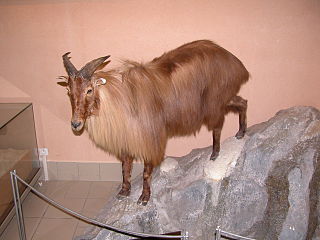 W
WHemitragus bonali, the Bonal tahr, is an extinct species of bovid from the Pleistocene of Europe and the Caucasus mountains region.
 W
WHexaprotodon is a genus of Hippopotamidae that was often applied to the pygmy hippopotamus before its reclassification into the genus Choeropsis. The name Hexaprotodon means "six front teeth" as some of the fossil forms have three pairs of incisors. The genus sensu lato, including African taxa, has been suggested to be paraphyletic with respect to both species of living hippopotamus. The uncontroversial, core Asian members of the genus most closely related to the type H. sivalensis were widespread throughout the Late Neogene and Quaternary of South and Southeast Asia, with the oldest records coming from the Late Miocene Siwaliks. They were extinct by the Late Middle Pleistocene in Southeast Asia, but survived in India until the terminal Pleistocene, with the latest dates being around 16,467–15,660 cal years Before Present.
 W
WThe High Arctic camel, from the mid-Pliocene epoch, is a fossil camel related to the fossil genus Paracamelus from which modern camels arose. It is also related to the extinct Ice Age Yukon giant camel. Collagen-containing fossils were found in 2006 near Strathcona Fiord on Ellesmere Island in Nunavut, Canada. The High Arctic camel lived at least 3.4 million years ago during a warmer period in a boreal-type forest environment.
 W
WHippopotamus antiquus, sometimes called the European hippopotamus, was a species of hippopotamus that ranged across Europe, becoming extinct some time before the last glacial period at the end of the Pleistocene epoch. Some scholars classify it as Hippopotamus amphibius antiquus, a subspecies of the modern common hippopotamus, Hippopotamus amphibius.
 W
WHippopotamus creutzburgi, the Cretan dwarf hippopotamus, is an extinct species of hippopotamus from the island of Crete. Hippopopotamus colonized Crete probably 800,000 years ago and lived there during the Middle Pleistocene. Bones of H. creutzburgi were found by Dorothea Bate on the Katharo plateau, in eastern Crete, in the 1900s. A similar species, the Cyprus dwarf hippopotamus lived on the island of Cyprus until the Holocene. It was at least 20% smaller than either subspecies of Cretan hippo.
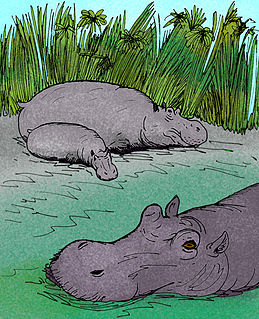 W
WHippopotamus gorgops is an extinct species of hippopotamus. It first appeared in Africa during the late Pliocene, and eventually migrated into Europe during the early Pleistocene. It became extinct during the Middle Pleistocene. Fossil records found at Ubeidiya, Israel suggested that they migrated out of Africa around 1.6 million years ago. Some have speculated that H. gorgops and H. behemoth are actually the same species given their similar sizes and where they have been found scientist believe it behaved almost identical to modern day hippopotamuses.
 W
WHippopotamus pentlandi is an extinct hippopotamus from Sicily. It arrived during the Pleistocene, in the Messinian salinity crisis. It is the largest of the insular dwarf hippos known from the Pleistocene of the Mediterranean, weighing in at 320 kg. It was present in Sicily until at least the latest Middle Pleistocene around 120 kya.
 W
WThe Irish elk, also called the giant deer or Irish deer, is an extinct species of deer in the genus Megaloceros and is one of the largest deer that ever lived. Its range extended across Eurasia during the Pleistocene, from Ireland to Lake Baikal in Siberia. The most recent remains of the species have been carbon dated to about 7,700 years ago in western Russia.
 W
WKolpochoerus is an extinct genus of the pig family Suidae related to the modern-day genera Hylochoerus and Potamochoerus. It is believed that most of them inhabited African forests, as opposed to the bushpig and red river hog that inhabit open brush and savannas. There are currently eight recognized species.
 W
WLeptobos is an extinct genus of large bovid found in Europe and Asia. It reached a weight up to 320 kg. It is often considered closely related to Bison and the insular Epileptobos. It is known from the Late Pliocene and Early Pleistocene of Europe, the Eastern Mediterranean, India (Siwaliks) and China. Leptobos syrticus from Libya likely represents another bovine taxon. The first appearance of Leptobos in Europe around 3.6-3.5 million years ago is considered to define the beginning of the Villafranchian faunal stage in Europe.
 W
WThe long-nosed peccary is an extinct mammal species of the peccary family (Tayassuidae). It is one of two peccary-species that existed in the US-Midwest during the last ice age.
 W
WMakapania is an extinct genus of large caprine or ovibovine from the Pliocene and Pleistocene of southern and East Africa. It is remarkable in that its horns were positioned laterally. Its body weight is estimated to have been about 263 kg.
 W
WMegaceroides algericus is an extinct species of deer known from the Late Pleistocene to Holocene of North Africa. It is one of only two species of deer known to have been native to the African continent, alongside the Barbary stag, a subspecies of red deer. It is considered to be closely related to the giant deer species of Eurasia.
 W
WMegaloceros is an extinct genus of deer whose members lived throughout Eurasia from the early Pleistocene to the beginning of the Holocene and were important herbivores during the Ice Ages. The largest species, Megaloceros giganteus, vernacularly known as the "Irish elk" or "giant elk", is also the best known. Fallow deer are thought to be their closest living relatives. Megaloceros is part of the deer family which includes moose, elk, reindeer, and other cervids.
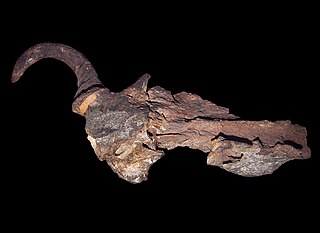 W
WMegalotragus was a genus of very large extinct African alcelaphines that occurred from the Pliocene to early Holocene. Its skull resembled that of modern hartebeests, but it differed in having a larger body size and wildebeest-like proportions. Megalotragus includes some of the largest bovid species in the tribe Alcelaphini, reaching a shoulder height of 1.4 m (4.6 ft). The genus consists of three species of which Megalotragus priscus survived until the early Holocene 7.500 C14yBP.
 W
WMegalovis is an extinct genus of bovid that lived in Eurasia during the Plio-Pleistocene.
 W
WMetridiochoerus is an extinct genus in the pig family indigenous to the Pliocene and Pleistocene of Africa. It is also known as the giant warthog.
 W
WMylohyus is an extinct genus of peccary found in North and Central America. It evolved in the Pliocene and its extinction is probably as recent as 9,000 years ago. It would have been familiar with early humans.
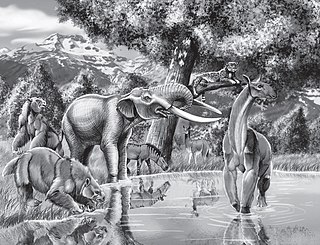 W
WPalaeolama is an extinct genus of laminoid camelid that existed from the Late Pliocene to the Early Holocene. Its range extended from North America to the intertropical region of South America.
 W
WParacamelus is an extinct genus of camel in the family Camelidae. It originated in North America during the Middle Miocene but crossed the Beringian land bridge into Eurasia during the Late Miocene, approximately 7.5–6.5 million years ago (Ma); its later range spanned from Spain and Italy to Chad and Shanxi Province, China. It is ancestral to living camels of the genus Camelus. A population remained in northern North America, which became the high Arctic camel, which survived until the Middle Pleistocene approximately 1 Ma.
 W
WPelorovis is an extinct genus of African wild cattle, which first appeared in the very beginning of the Pleistocene, 2.5 million years ago, and became extinct at the end of the Late Pleistocene about 12,000 years ago or even during the Holocene, some 4,000 years ago.
 W
WPlatygonus is an extinct genus of herbivorous peccaries of the family Tayassuidae, endemic to North and South America from the Miocene through Pleistocene epochs, existing for about 10.289 million years. This species grew up to lengths of 3.3 feet long and stood 2.5 feet tall.
 W
WPraemegaceros is an extinct genus of deer. It also contains the subgenera Orthogonoceros and Nesoleipoceros. It has sometimes been synonymised with Megaloceros and Megaceroides, however they have been found to be generically distinct.
 W
WSivatherium is an extinct genus of giraffids that ranged throughout Africa to the Indian subcontinent. The species Sivatherium giganteum is, by weight, one of the largest giraffid known, and also one of the largest ruminants of all time. The Afro-Asiatic species, S. maurusium, was once placed within the genus "Libytherium".
 W
WSoergelia is a genus of extinct ovibovine caprine that was common across Europe, North America and Asia in the Pleistocene epoch.
 W
WSus strozzi, or Strozzi's pig, was a suid native to the Mediterranean region of Europe. It was more ancient than the boar, and was eventually displaced by the latter when it entered Europe during the start of the Pleistocene, 1 Mya.
 W
WSyncerus antiquus, is an extinct species of bovid from the Pleistocene of Africa. It was one of the largest species in its family, potentially weighing up to 2,000 kilograms (4,400 lb). Due to this fact, it is sometimes known as the African giant buffalo. Syncerus antiquus became extinct at the end of the Late Pleistocene about 12,000 years ago or even during the Holocene, some 4,000 years ago.
 W
WTitanotylopus is an extinct genus of terrestrial herbivore in the family Camelidae, endemic to North America from the late Hemphillian stage of the Miocene through the Irvingtonian stage of the Pleistocene. It was one of the last surviving North American camels, after its extinction, only Camelops remained. Its closest living relative is the Bactrian Camel.